The Paint Ingredient Market is estimated to be valued at USD 1.8 billion in 2025 and is projected to reach USD 2.5 billion by 2035, registering a compound annual growth rate (CAGR) of 3.2% over the forecast period.
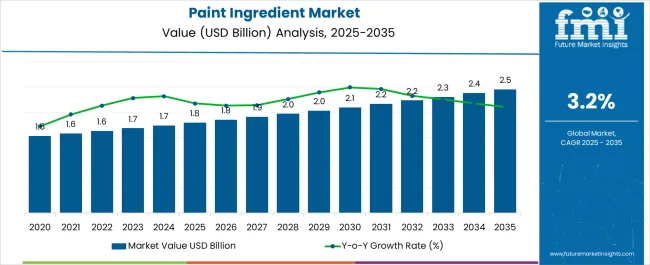
| Metric | Value |
|---|---|
| Paint Ingredient Market Estimated Value in (2025 E) | USD 1.8 billion |
| Paint Ingredient Market Forecast Value in (2035 F) | USD 2.5 billion |
| Forecast CAGR (2025 to 2035) | 3.2% |
The paint ingredient market is witnessing consistent growth, supported by increasing demand for high-performance coatings across residential, industrial, and commercial sectors. Rising urbanization, renovation trends, and regulatory pressure for environmentally friendly formulations are reshaping production and procurement strategies.
Technological advancements in formulation precision and the rise of smart dispensing systems have strengthened process efficiency and consistency. The market is also being influenced by the need for longer-lasting, corrosion-resistant, and aesthetically adaptable coatings, which is accelerating innovation in both mixers and material inputs.
Sustainable sourcing, VOC compliance, and recyclability have become key decision drivers for manufacturers and end users alike. Future growth is expected to be reinforced by automation integration, digital quality monitoring, and expansion into value-added coatings for specialty construction and infrastructure applications.
The market is segmented by Product Type, Application, Material, and Sales Channel and region. By Product Type, the market is divided into Automatic Paint Ingredient Mixer, Manual Paint Ingredient Mixer, and Semi-Automatic Paint Ingredient Mixer. In terms of Application, the market is classified into Paint Ingredient for House Decoration, Paint Ingredient for Paint Manufacturers, Paint Ingredient for Paint Users, and Paint Ingredient for Other Applications. Based on Material, the market is segmented into Metal-based Paint Ingredients, Wood-based Paint Ingredients, Steel-based Paint Ingredients, Plastic-based Paint Ingredients, and Other Materials-based -based Paint Ingredients. By Sales Channel, the market is divided into Paint Ingredient Sales via Specialty Stores, Paint Ingredient Sales via Hypermarkets/Supermarkets, Paint Ingredient Sales via Departmental Stores, Paint Ingredient Sales via Convenience Stores, Direct Paint Ingredient Sales, Paint Ingredient Sales via Online Retailing, and Paint Ingredient Sales via Other Sales Channels. Regionally, the market is classified into North America, Latin America, Western Europe, Eastern Europe, Balkan & Baltic Countries, Russia & Belarus, Central Asia, East Asia, South Asia & Pacific, and the Middle East & Africa.
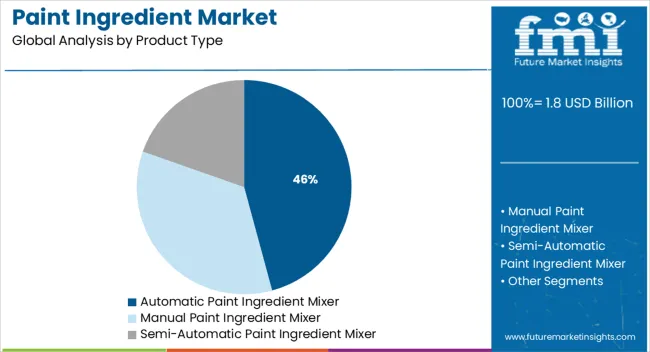
Automatic paint ingredient mixers are projected to account for 45.8% of total revenue in the paint ingredient market in 2025, establishing them as the leading product type. This segment's dominance is being shaped by increasing automation across production lines and the need for higher accuracy in paint formulation.
These systems enable consistent mixing of pigments, binders, and additives while minimizing human error and batch variation. The reduced downtime, faster throughput, and better energy efficiency offered by automatic mixers are encouraging their adoption among mid to large-scale manufacturers.
Their integration with smart control panels and digital interfaces further enhances process traceability and compliance in regulated environments, contributing to widespread acceptance across decorative and industrial applications.
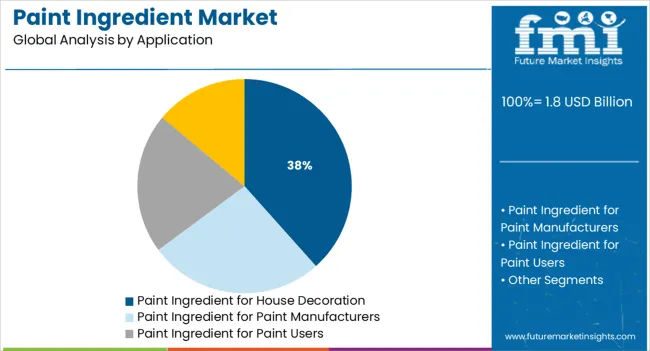
Paint ingredients used for house decoration are expected to hold a 38.4% share of market revenue in 2025, making them the top application segment. This leadership is being driven by rising residential construction, remodeling activities, and increased consumer interest in aesthetic customization.
Demand for low-VOC, washable, and durable paints has surged, prompting the use of specialized additives, stabilizers, and dispersants tailored for home use. Consumer awareness regarding indoor air quality and eco-certified products is pushing brands to invest in ingredient transparency and advanced formulation.
Moreover, the trend toward DIY and home improvement has increased retail demand for high-quality, pre-mixed ingredients that offer both ease of application and visual enhancement.
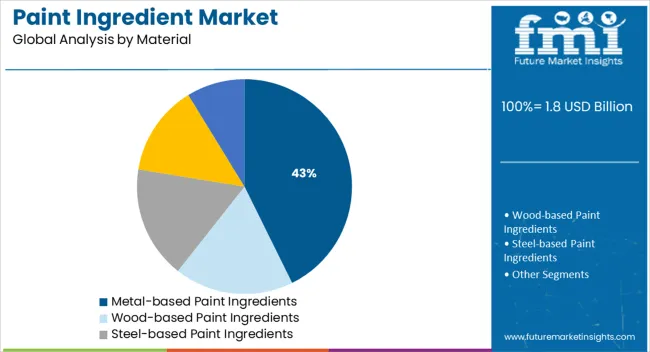
Metal-based paint ingredients are forecast to contribute 42.7% of the overall market share in 2025, positioning them as the most utilized material segment. Their widespread use stems from superior durability, corrosion resistance, and reflectivity, which are essential for both architectural and industrial coatings.
Metal-based additives and pigments, such as zinc oxide and aluminum flakes, offer improved barrier protection and thermal stability, making them suitable for long-term applications. This segment's growth is also being supported by rising demand for heat-reflective and anti-microbial coatings in infrastructure and equipment.
As performance specifications tighten across sectors, metal-based ingredients continue to gain traction for their reliability and extended lifecycle value.
Paint mixers are one of the most profitable businesses these days. Various aspects of the economy require a high amount of paint. In addition to technological advancements, the introduction of innovative products such as automatic paint mixers and other products is expected to boost future growth.
In recent years, eco-friendly paints have become more popular because of their odorless qualities and lower negative environmental impact. The market is growing as people switch to environmentally friendly products. With the advancement of technology, automatic paint mixers have been developed to reduce labor and worker intervention in paint mixing.
In the newly developed and advanced automatic mixer, powders and pigments are blended with polyurethane, epoxy, polyester, and acrylic resins without the presence of any air.
Increasing demand for DIY projects as well as experimentation with paints, often driven by the emerging social media trend, is supporting the growth of the market for paint Ingredients. Many users are trying out unique color combinations, textures, and even scents that can be incorporated into their paint with effective paint Ingredients.
Further, the market is expected to benefit from higher consumption of automotive, construction, and general industrial products. Several emerging countries where there are high rates of urbanization and industrialization, such as India, China, and Southeast Asia, are expected to see a rapid rise in the demand for products in various applications.
The increasing cost of handheld and automated machines on the market is likely to hamper the growth of the market. Although there are a few designs that look impressive, they present an ineffective way of mixing them, which in turn could further hamper the market's growth.
Economic slowdowns in developing countries will also hamper the growth of this market. As a consequence of high raw material costs, it will be even harder for the paint ingredients market to grow as a whole in the future.
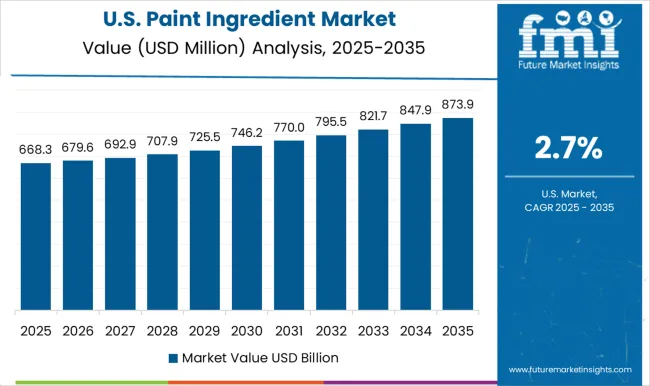
According to the forecast, North America will continue to have a high demand for paint ingredients. Globally, this region is expected to hold 22% of the market share in 2025. The region's dominance in the market is likely to be enhanced by the presence of key players and the increased demand for automobiles in this region.
The growing middle-class population, low labor costs, and low operating costs have made North America an attractive location for companies to set up manufacturing facilities.
Therefore, there has been an increase in the number of industrial facilities in the region, resulting in an increase in construction activities, which is expected to increase the demand for paint mixers in the future.
Further, e-commerce's rapid growth in the region provides producers with lucrative opportunities to gain market share, thereby driving demand for their products.
Globally, Europe is expected to hold the largest market for paint ingredients. The market for paint mixers is expected to grow significantly in the coming years in Europe, and the demand is predicted to increase by a large margin in the future. According to estimates, the market will hold a market share of 24% by the end of 2025.
The construction industry is expected to grow in several countries, including the United Kingdom, the Netherlands, Hungary, Sweden, Germany, Poland, and Ireland over the forecast period due to expanding construction industry.
As a result of EU funding and various support measures taken by governmental organizations in the region, it is expected that the construction sector will grow in the region, increasing the demand for the product.
Based on application the market is segmented into house decoration, paint manufacturers, paint users, and others. According to analysts, paint manufacturers in the market are projecting the highest growth for paint ingredients in the market.
Market growth for paint ingredients has been attributed to a growing demand for painting and dyeing operations on a commercial scale, lowering the price of paint ingredients in the market.
As a result of the compact design and the ability to provide rapid and effective mixing, these mixers are ideal for pharmaceutical and confectionery edible industries. With this machine, the paint manufacturer produces ink of excellent consistency, ideal for printing tablets and capsules in the market.
Start-ups are bringing paint ingredient products to the forefront due to a growing demand for eco-friendly products in the market. Furthermore, these consumer products start-up companies are engaged in a wide range of production, distribution, and marketing activities in addition to supplying non-synthetic paint and coatings in the market.
Paint ingredients are employed in a wide variety of metal and wood coatings, so the most eco-friendly and sustainable paint ingredients are utilized in the automotive and construction industries.
Key players in the global paint ingredient market include HYDE, Shur-Line, Premier Paint Roller, Goldblatt, WESTWARD, RADIA, Badger Air-Brush Co., DAYTON, Marshalltown, RUST-OLEUM, PREMIER, TBC Mixer, Mixing Mate, AllwayTools, Red Devil, Marshalltown, Sherwin-Williams, DYNAMIX AGITATORS, Allways Tools, COAT, MadeByPaint, and Bosch.
| Report Attribute | Details |
|---|---|
| Growth Rate | CAGR of 3.2% from 2025 to 2035 |
| Market Value in 2025 | USD 1.8 billion |
| Market Value in 2035 | USD 2.5 billion |
| Base Year for Estimation | 2024 |
| Historical Data | 2020 to 2024 |
| Forecast Period | 2025 to 2035 |
| Quantitative Units | Revenue in USD Million and CAGR from 2025 to 2035 |
| Report Coverage | Revenue Forecast, Company Ranking, Competitive Landscape, Growth Factors, Trends, and Pricing Analysis |
| Segments Covered | Product Type, Application, Material, Sales Channel, Region |
| Regions Covered | North America; Latin America; Europe; Asia Pacific; Middle East and Africa |
| Key Countries Profiled | USA, Canada, Brazil, Mexico, Germany, United Kingdom, France, Spain, Italy, China, Japan, South Korea, Thailand, Singapore, Indonesia, Australia, New Zealand, GCC Countries, South Africa, Israel |
| Key Companies Profiled | HYDE; Shur-Line; Premier Paint Roller; Goldblatt; WESTWARD; RADIA; Badger Air-Brush Co.; DAYTON; Marshalltown; RUST-OLEUM; PREMIER; TBC Mixer; Mixing Mate; AllwayTools; Red Devil; Sherwin-Williams; DYNAMIX AGITATORS; Bosch |
| Customization | Available Upon Request |
The global paint ingredient market is estimated to be valued at USD 1.8 billion in 2025.
The market size for the paint ingredient market is projected to reach USD 2.5 billion by 2035.
The paint ingredient market is expected to grow at a 3.2% CAGR between 2025 and 2035.
The key product types in paint ingredient market are automatic paint ingredient mixer, manual paint ingredient mixer and semi-automatic paint ingredient mixer.
In terms of application, paint ingredient for house decoration segment to command 38.4% share in the paint ingredient market in 2025.






Our Research Products

The "Full Research Suite" delivers actionable market intel, deep dives on markets or technologies, so clients act faster, cut risk, and unlock growth.

The Leaderboard benchmarks and ranks top vendors, classifying them as Established Leaders, Leading Challengers, or Disruptors & Challengers.

Locates where complements amplify value and substitutes erode it, forecasting net impact by horizon

We deliver granular, decision-grade intel: market sizing, 5-year forecasts, pricing, adoption, usage, revenue, and operational KPIs—plus competitor tracking, regulation, and value chains—across 60 countries broadly.

Spot the shifts before they hit your P&L. We track inflection points, adoption curves, pricing moves, and ecosystem plays to show where demand is heading, why it is changing, and what to do next across high-growth markets and disruptive tech

Real-time reads of user behavior. We track shifting priorities, perceptions of today’s and next-gen services, and provider experience, then pace how fast tech moves from trial to adoption, blending buyer, consumer, and channel inputs with social signals (#WhySwitch, #UX).

Partner with our analyst team to build a custom report designed around your business priorities. From analysing market trends to assessing competitors or crafting bespoke datasets, we tailor insights to your needs.
Supplier Intelligence
Discovery & Profiling
Capacity & Footprint
Performance & Risk
Compliance & Governance
Commercial Readiness
Who Supplies Whom
Scorecards & Shortlists
Playbooks & Docs
Category Intelligence
Definition & Scope
Demand & Use Cases
Cost Drivers
Market Structure
Supply Chain Map
Trade & Policy
Operating Norms
Deliverables
Buyer Intelligence
Account Basics
Spend & Scope
Procurement Model
Vendor Requirements
Terms & Policies
Entry Strategy
Pain Points & Triggers
Outputs
Pricing Analysis
Benchmarks
Trends
Should-Cost
Indexation
Landed Cost
Commercial Terms
Deliverables
Brand Analysis
Positioning & Value Prop
Share & Presence
Customer Evidence
Go-to-Market
Digital & Reputation
Compliance & Trust
KPIs & Gaps
Outputs
Full Research Suite comprises of:
Market outlook & trends analysis
Interviews & case studies
Strategic recommendations
Vendor profiles & capabilities analysis
5-year forecasts
8 regions and 60+ country-level data splits
Market segment data splits
12 months of continuous data updates
DELIVERED AS:
PDF EXCEL ONLINE
Paint Cans Market Size and Share Forecast Outlook 2025 to 2035
Painting Robots Market Size and Share Forecast Outlook 2025 to 2035
Paint Curing Lamp Market Size and Share Forecast Outlook 2025 to 2035
Paint Booth Market Size and Share Forecast Outlook 2025 to 2035
Painting Tool Market Size and Share Forecast Outlook 2025 to 2035
Paint Rollers Market Size and Share Forecast Outlook 2025 to 2035
Paint Tester Market Size and Share Forecast Outlook 2025 to 2035
Paint Knife Market Size and Share Forecast Outlook 2025 to 2035
Paint Buckets Market Size, Share & Forecast 2025 to 2035
Paint Mixing Market Analysis - Size, Share, and Forecast Outlook for 2025-2035
Market Share Breakdown of Paint Protection Film Manufacturers
Market Share Insights of Paint Can Manufacturers
Paint Additives Market Growth 2024-2034
Faux Paints And Coatings Market Size and Share Forecast Outlook 2025 to 2035
Spray Painting Machine Market Size and Share Forecast Outlook 2025 to 2035
Small Paint Pail Market Size and Share Forecast Outlook 2025 to 2035
Metal Paint Tray Market Size and Share Forecast Outlook 2025 to 2035
Epoxy Paint Thinner Market Growth - Trends & Forecast 2025 to 2035
Epoxy Paint Market Growth – Trends & Forecast 2024-2034
Metal Paint Can Market Trends & Industry Growth Forecast 2024-2034

Thank you!
You will receive an email from our Business Development Manager. Please be sure to check your SPAM/JUNK folder too.
Chat With
MaRIA